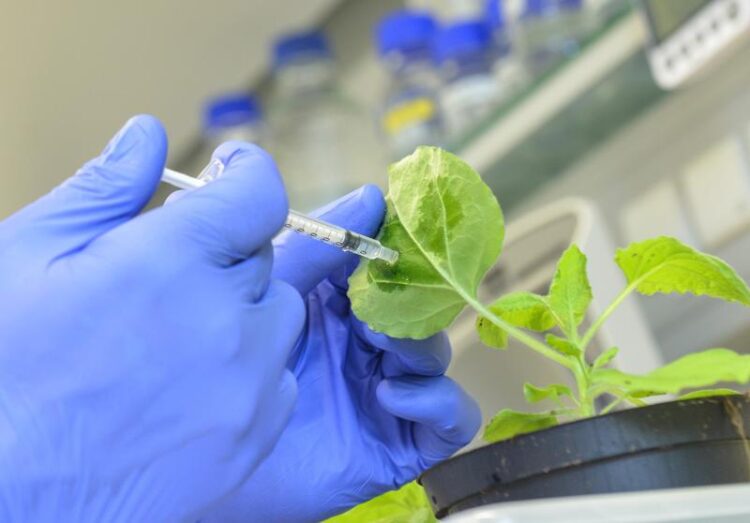Scientists develop novel RNA- or DNA-based substances to protect plants from viruses

The new active ingredients can be used to protect plants against viruses.
(c) Uni Halle / Markus Scholz
Individually tailored RNA or DNA-based molecules are able to reliably fight off viral infections in plants, according to a new study by the Martin Luther University Halle-Wittenberg (MLU), which was published in the “International Journal of Molecular Sciences”. The researchers were able to fend off a common virus using the new active substances in up to 90 per cent of cases. They also developed a method for finding substances tailored specifically to the virus. The team has now patented the method.
During a viral infection, the plant’s cells are hijacked by the virus to multiply itself. Key products of this process are viral RNA molecules that serve as blueprints for the production of proteins. “A virus cannot reproduce without producing its proteins,” explains Professor Sven-Erik Behrens from the Institute of Biochemistry and Biotechnology at MLU. For years, his team has been working on ways to disrupt this process and degrade the viral RNA molecules inside the cells.
In the new study, the researchers describe how this can be achieved using the so-called “antisense” method. It relies on short, synthetically produced DNA molecules known as antisense oligonucleotides (ASOs). In the plant cells, the ASOs direct cellular enzymes acting as scissors towards the foreign RNA so they can degrade it. “For this process to work, it is crucial to identify a suitable target structure in the viral RNA which the enzyme scissors can attach to,” explains Behrens. However, findings those accessible sites is really tricky: most potential target RNA molecules have a very complex structure, and they are also masked by other cell components. “This makes it even more difficult to attack them directly,” says Behrens.
Behrens’ team faced this problem several years ago when they sought to use short RNA molecules (siRNA) to optimise a similar process in plants known as RNA interference. At the time, the researchers were able to develop a method for identifying suitable and accessible sites in viral RNA. The new study shows that the same approach can also be used for ASOs and that these active substances have a similar protective effect in plants. “We were pleasantly surprised by the results because we were not sure if it would work. Even though RNA interference and antisense operate in a similar way, the active enzyme complexes are completely different. However, we were able to show that the RNA sites determined using our method are actually accessible for both processes,” says Behrens. The results were impressive: Experiments using the optimised ASO active substances showed that plants were protected against infection with a model virus in up to 90 percent of the cases.
The team has since patented the method. Behrens now hopes to fine-tune the approach. “ASOs are not only very precise, they are also relatively easy and inexpensive to produce. Similar active substances have also been used in humans for several years with few side effects. This is another argument in favour of their potential use in food,” says Behrens. The biochemist is also looking into other applications of the newly developed methods, for example in fending off viruses that infect humans.
Both the patent and the study represent an important milestone in the “RNA PROTECT” research project at MLU, which is receiving around 1.2 million euros in funding from the Federal Ministry of Education and Research. The aim is to test the marketability of MLU’s research work in this area and, ideally, to set up a company. The study was also funded by the State of Saxony-Anhalt and the Deutsche Forschungsgemeinschaft (German Research Foundation, DFG).
Originalpublikation:
Study: Gruber C. et al. Effective Antiviral Application of Antisense in Plants by Exploiting Accessible Sites in the Target RNA. International Journal of Molecular Sciences (2023). doi: 10.3390/ijms242417153
https://doi.org/10.3390/ijms242417153
Patent: Behrens S.E. et al. Zuverlässige Identifikation von Bereichen (,a-Sites’) in komplexen RNA Molekülen, die zugänglich sind für Nukleinsäuren oder Komplexe von Nukleinsäuren mit Endonukleasen DE 10 2021 107 508 A1
https://pressemitteilungen.pr.uni-halle.de/index.php?modus=pmanzeige&pm_id=5715
Media Contact
All latest news from the category: Life Sciences and Chemistry
Articles and reports from the Life Sciences and chemistry area deal with applied and basic research into modern biology, chemistry and human medicine.
Valuable information can be found on a range of life sciences fields including bacteriology, biochemistry, bionics, bioinformatics, biophysics, biotechnology, genetics, geobotany, human biology, marine biology, microbiology, molecular biology, cellular biology, zoology, bioinorganic chemistry, microchemistry and environmental chemistry.
Newest articles

First-of-its-kind study uses remote sensing to monitor plastic debris in rivers and lakes
Remote sensing creates a cost-effective solution to monitoring plastic pollution. A first-of-its-kind study from researchers at the University of Minnesota Twin Cities shows how remote sensing can help monitor and…

Laser-based artificial neuron mimics nerve cell functions at lightning speed
With a processing speed a billion times faster than nature, chip-based laser neuron could help advance AI tasks such as pattern recognition and sequence prediction. Researchers have developed a laser-based…

Optimising the processing of plastic waste
Just one look in the yellow bin reveals a colourful jumble of different types of plastic. However, the purer and more uniform plastic waste is, the easier it is to…



